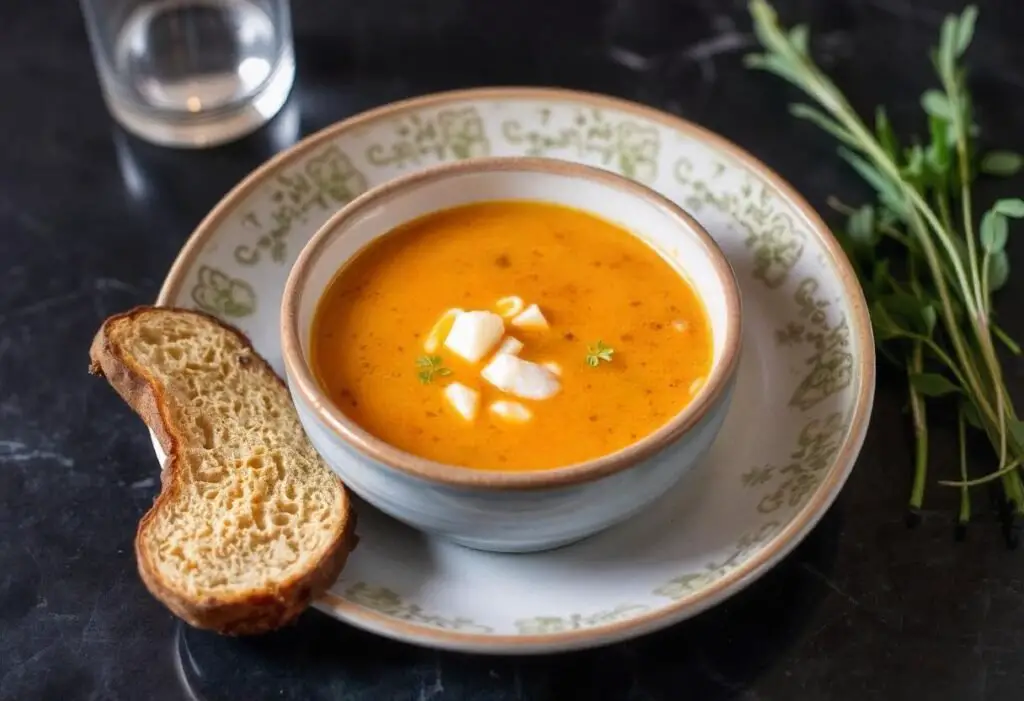Table of Contents
Introduction: Savoring the Flavors of Maryland

Tucked in on the Atlantic coast, Maryland boasts an extremely well-known heritage of seafood, and the most iconic dish that embodies the spirit of Maryland cuisine is the much-loved Maryland crab soup. It is rather much more than just a meal- it’s almost a feast of the rich bounty of waters of Chesapeake Bay and culinary traditions passed on through generations. For locals and visitors alike, tasting Maryland crab soup is something everyone in the Maryland crowd needs to experience to get the true taste of real Maryland. We’ll tell you what makes Maryland crab soup unique, then give you a detailed recipe, followed by general tips and variations to get you started.
What Makes Maryland Crab Soup Unique?
Among all the sea dishes, the outstanding dish from Maryland is undoubtedly crab soup. In principle, it is a fantastic mixture of fresh ingredients, especially with the place of honor going to the iconic blue crab so closely associated with the culinary world of Maryland. The sweet, fresh meat of the crab combined with savory broth and spices has curative and stimulating properties.
Another characteristic feature of Maryland crab soup is that it is derived from old Bay seasoning. That traditional herbs and spices combination was introduced in the 1940s, and since then, among Marylanders, it has become an established flavor of seafood. It gives this soup a unique flavor, with crab tasting extremely delicate and sweet by nature. In most cases, the medley of vegetables consisting of onions, celery, and bell peppers adds depth and texture to the soup in each spoonful.
Besides the ingredients, Maryland crab soup also holds significant cultural value. It is the epitome of fishermen’s and families’ creativity and resourcefulness to survive on the Bay’s bounty. Having a bowl of this soup often evokes memories of a family gathering or just another summer day near the water. This is why so many Marylanders love it.
Essential Ingredients for the Perfect Maryland Crab Soup
Fresh Maryland Blue Crabs: Why They Matter
Because, of course, any Maryland crab soup’s star is going to be the blue crab. Virtually no other species of crab tastes nearly as well. Its very sweet and tender meat captures the essence of the Chesapeake Bay flavor. Fresh is the order of the day in buying crabs for your soup. If feasible, buy live crabs or freshly steamed ones-from a local seafood market. This will yield you the best possible flavor.
Aromatic Vegetables: Onions, Celery, and Bell Peppers
A good crab soup needs a good aromatic foundation from the vegetables. Chopped onions, celery, and bell peppers add a wonderful underlying aroma and depth to the broth. At the same time, they add a pleasant crunch to balance out the tender crab meat.
Spices and Seasonings: Old Bay and Beyond
No genuine Maryland crab soup ever is complete without Old Bay seasoning. It is a quintessential mix of celery salt, black pepper, paprika, and so forth, the only way to achieve that instantly classic flavor. Fresh herbs-think parsley or thyme-ping for brightness. For those of you who like it a bit hot, add some cayenne pepper or even better, some crushed red pepper flakes.
Step-by-Step Guide to Crafting Maryland Crab Soup
Preparation: Cleaning and Preparing the Crabs
First, to make excellent Maryland crab soup, you have to process your crabs. If you purchase your crabs alive, then you must clean them. Under cold running water, rinse your crabs so that all loose debris is removed. Take the meat from the cooked shells; be sure to keep the pieces intact. Reserve this crab meat for later preparation.
Cooking: Building Layers of Flavor
- Sauté the Vegetables: Use enough olive oil to grease a large pot and let it be placed over medium heat. Add chopped onions, celery, and bell peppers. Sauté the vegetables for about 5 to 7 minutes, or until softened and onions turn translucent.
- Add Spices: Sprinkle Old Bay seasoning, as well as any spice that you may want to add. Mix for about a minute so that the spices can penetrate and all the aromas can come out.
- Add some broth: Now add chicken or seafood broth to the pot and mix all the ingredients. Or, if you have homemade stock, then it is always wonderful to add a little deeper flavor. Cook it softly.
- Add Crab Meat to it: Once the broth is warmed up to simmer, add the crab meat that was prepared earlier. Mix the crab well, being careful not to break it too much.
- Simmer and Season: Simmer this soup for the last 15 to 20 minutes, allowing all flavors to fuse well together. Taste and season as required to your choice by adding more Old Bay or salt.
Serving Suggestions: Best Sides and Pairings
This Maryland crab soup is delicious when served hot, right out of the pot. Traditional Maryland can be served over bowls with fresh parsley on top as a garnish to add some pop of color to the dish. Warm crusty bread or saltine crackers complement the warmth of the rich flavors of the soup nicely. Coleslaw on the side adds that nice crunch to keep the palate refreshed.
Check Out: Salmon Chowder: A Creamy Seafood Delight.
Variations on the Classic Maryland Crab Soup

While most of them still hold onto the original, it is indeed patent that the original Maryland crab soup has already had many changes depending on the consumer’s preference and taste.
Creamy vs. Broth-Based: Choosing Your Style
Among the most obvious distinctions of Maryland crab soup is its creamy or broth-based nature. Sometimes, a version is made with heavy cream or milk, which can make it very rich and thick. For a creamy version, stir in a cup of heavy cream at the last stage of cooking, warming it up.
On the other hand, it is the broth-based soup that really puts much emphasis on the transparent, savory broth, which may help bring out the natural sweetness of the crab. It is also one of the leaner versions that people go for in order to obtain a healthier version.
Adding Twists: Vegetables, Corn, and Other Enhancements
Get creative with your Maryland crab soup! Some people like a few kernels of corn for sweetness and some extra texture. A carrot or two, or a zucchini, could add nutrients. A few dashes of hot sauce or a squeeze of lemon juice at serving time could provide a fun kick.
Tips for the Best Maryland Crab Soup
Making the best Maryland crab soup actually does require a little practice, but with the right tips, your dish is sure to be restaurant quality.
Sourcing Fresh Ingredients
Any fresh, local ingredients should be available whenever possible. Attending a farmer’s market or a good seafood market will usually yield the best quality of crabs and vegetables. If there are no fresh blue crabs in season, frozen crab meat labeled as “fresh” will do, as it is usually frozen shortly after being caught.
Storing and Reheating Leftovers
When you do have leftovers (which is rare with this delicious soup!), you can store them in a fresh, airtight container in the refrigerator for up to three days. Then, when reheating, do so gently over low heat on the stove in order not to toughen your crab meat.
Conclusion: Enjoying Maryland Crab Soup at Home
And there you have it: all the resources to prepare your Maryland crab soup. From hand-picking fresh ingredients to perfect seasoning, it’s all little steps that bring you closer and closer to that one bowl of this soup at home. Get all your friends over and enjoy those good flavors of Maryland. Whether it is a special occasion or a cozy night, Maryland crab soup will undoubtedly make an impression.
For more details: Click Here.
FAQs About Maryland Crab Soup
Can I use frozen crabs for this recipe?
Indeed, you can use frozen crab meat, however, it is very important to note that the water content in the crab meat may differ. But preferably, freshwater crabs must be used for a much better taste and texture as compared to the cooked ones.
What can I substitute for Old Bay seasoning?
If you do not have any Old Bay, then you can often improvise the necessary seasoning mix using paprika, celery salt, ground black pepper, and a pinch of cayenne.
How long can I store Maryland crab soup?
Maryland crab soup should be kept in the refrigerator for up to 3 days. It can also be frozen for up to 3 months, and can also be refrigerated for up to 3 months.





